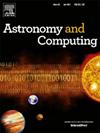Classification of spiral galaxies by spiral arm number using convolutional neural network
IF 1.8
4区 物理与天体物理
Q2 ASTRONOMY & ASTROPHYSICS
引用次数: 0
Abstract
The structural information of spiral galaxies such as the spiral arm number, offer valuable insights into the formation processes of spirals and their physical roles in galaxy evolution. We developed classifiers based on convolutional neural networks (CNNs) using variants of the EfficientNet architecture with different transfer learning techniques and pre-trained weights to categorise spiral galaxies by their number of spiral arms. A selected dataset from Galaxy Zoo 2, comprising 11 718 images filtered based on appropriate criteria is used for training and evaluation. Both the V2M model (EfficientNetV2M architecture fine-tuned on ImageNet) and the B0 model (EfficientNetB0 architecture with Zoobot pre-trained weights) achieved high accuracy on the down-sampled dataset, with most performance metrics exceeding 0.8 across all classes, except for galaxies with 4 arms due to the limited number of samples in this category. Merging higher-arm-number classes (more than 4 arms) improved the V2M model’s accuracy significantly for 4-arm galaxies, as this approach allowed the model to focus on more distinct features within fewer, broader categories with a more balanced class distribution. GradCAM++ and SmoothGrad highlight the networks’ effectiveness in classifying galaxies, through the distinction of the galaxy structures and the extraction of the spiral arms, with the V2M model showing better capabilities in both tasks. Lower-arm galaxies tend to be misclassified as “can’t tell” when their spiral arms are not clearly visible, while higher-arm galaxies tend to be misclassified as having fewer arms when their features are only partially detected. The study also found that galaxies with 3 arms tend to have lower stellar masses, and this tendency is reduced in the model predictions. The models’ mispredictions between 2-arm and 1/3-arm are likely resulting from external interference and dynamic nature of spiral arms. The V2M model prediction also shows a slight tendency towards higher stellar mass in many-arm galaxies.
利用卷积神经网络根据旋臂数对螺旋星系进行分类
螺旋星系的结构信息,如旋臂数,为螺旋星系的形成过程及其在星系演化中的物理作用提供了有价值的见解。我们开发了基于卷积神经网络(cnn)的分类器,使用effentnet架构的变体,采用不同的迁移学习技术和预训练的权重,根据螺旋星系的旋臂数量对其进行分类。从银河动物园2中选择了一个数据集,其中包括11718张基于适当标准过滤的图像,用于训练和评估。V2M模型(effentnetv2m架构在ImageNet上微调)和B0模型(effentnetb0架构与Zoobot预训练权值)在下采样数据集上都取得了很高的准确性,大多数性能指标在所有类别中都超过0.8,除了具有4个臂的星系,因为这个类别中的样本数量有限。合并高臂数的星系(超过4个臂)大大提高了V2M模型对于4臂星系的准确性,因为这种方法使模型能够在更少、更广泛的类别中关注更明显的特征,并具有更平衡的类别分布。通过区分星系结构和提取旋臂,GradCAM++和SmoothGrad突出了网络在星系分类方面的有效性,其中V2M模型在这两项任务中都表现出更好的能力。当低臂星系的旋臂不清晰可见时,它们往往被错误地归类为“无法分辨”,而当高臂星系的特征只被部分探测到时,它们往往被错误地归类为旋臂较少。该研究还发现,拥有3条旋臂的星系往往拥有更低的恒星质量,而这种趋势在模型预测中被削弱了。模型在2臂和1/3臂之间的错误预测可能是由于外部干扰和螺旋臂的动态特性造成的。V2M模型的预测也显示了在多臂星系中恒星质量趋向较高的轻微趋势。
本文章由计算机程序翻译,如有差异,请以英文原文为准。
求助全文
约1分钟内获得全文
求助全文
来源期刊

Astronomy and Computing
ASTRONOMY & ASTROPHYSICSCOMPUTER SCIENCE,-COMPUTER SCIENCE, INTERDISCIPLINARY APPLICATIONS
CiteScore
4.10
自引率
8.00%
发文量
67
期刊介绍:
Astronomy and Computing is a peer-reviewed journal that focuses on the broad area between astronomy, computer science and information technology. The journal aims to publish the work of scientists and (software) engineers in all aspects of astronomical computing, including the collection, analysis, reduction, visualisation, preservation and dissemination of data, and the development of astronomical software and simulations. The journal covers applications for academic computer science techniques to astronomy, as well as novel applications of information technologies within astronomy.
 求助内容:
求助内容: 应助结果提醒方式:
应助结果提醒方式:


